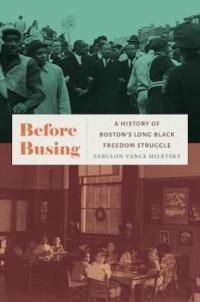February 22, 2024

Murphy School students on a peaceful first day of school in 2010. Chris Lovett photo

For many in Boston, the story of “busing” begins in September 1974 with the explosive clash over mandatory desegregation of the city’s public schools. In the barrage of electrifying news reports, with angry white faces and violent attacks on busloads of Black students in South Boston, the word assumed a charge of its own, evoking white resistance to the dictates of a federal judge.
More explicit in the news footage was Boston’s racial divide. From one side, there was pushback against Judge W. Arthur Garrity, with a neighborhood closing ranks against what it saw as an invasion of outsiders. From the other side, the violence over desegregation—even cycling into retaliatory attacks on whites—was an ugly outgrowth of Boston’s long entrenched racism.
RELATED: Historian and author Zebulon Miletsky on why he wrote "Before Busing."
In his book “Before Busing: A History of Boston’s Long Black Freedom Struggle,” Zebulon Vance Miletsky highlights what the violence and division eclipsed. His intent, as he put it, was a book in which “Black agency and activism take center stage, situating the busing program as the culmination of nearly three decades of consistent political organizing by Black Bostonians.”
Miletsky’s clock starts ticking purposefully in the late 1700s, with Prince Hall, the Black leader in Boston who fought in the War of Independence and founded the first Black masonic lodge. Despite the universal education requirement in Massachusetts dating to 1642, many Black students were denied admission to Boston’s taxpayer-supported public schools. Hall and other Black parents tried to overcome the barrier through unsuccessful appeals to the Legislature and the Boston School Committee.
In response to those setbacks, Hall opened a school for Black students in the home of his son, which would expand in 1806 into a classroom at the African Meeting House on Beacon Hill. As Miletsky frames it, this was the beginning of a pattern of white exclusion and Black initiative that would play out more than a century-and-a-half later in Boston’s “freedom schools.” Nor was Prince Hall the last Black parent to pursue educational justice by going outside Boston’s public schools.
“Before Busing” also explores evolving ideas of what Boston’s Black community wanted from education. By the end of the 19th century, there was broad support, even by many relatively progressive leaders, for separate educational tracks, as with the technical schools espoused and developed by Booker T. Washington. The educational principle would be enshrined in the “separate-but-equal” ruling by the US Supreme Court in 1896.
Washington would later be challenged at a 1903 confrontation in Boston by William Monroe Trotter, a Harvard-educated activist and publisher who moved to Dorchester’s Jones Hill in 1899. Trotter believed that Black students should not be confined to a separate track, which often turned out – in practice, if not by design –to be inferior. As sociologists would later conclude, the boundaries of tracking can be internalized in a way that cramps student achievement.
Sixty years later, Black parents and activists would seek an alternative to lower expectations by setting up independent schools, with more Black models of achievement. If few white students could match the achievement of the most illustrious white models, the problem for Black students in the public schools was the invisibility of Black models, compounded by a scarcity of Black educators.
In the decade before 1974, Miletsky highlights the community organizing and its overlap with the Civil Rights Movement. If the goal in Boston’s schools was equality, as in building conditions and instruction materials, it was also about developing a new definition of learning that could help students thrive. Most importantly, Miletsky makes the Black leadership visible and names the names including Ruth Batson, Tom Atkins, Mel King, Muriel Snowden, Hubie Jones, and Jean McGuire.
The educational inequality the leaders tried to address was documented in 1965 by a state commission and, as early as 1944, in a study for the Boston Finance Commission. Long before the federal lawsuit filed by Black parents in 1972, the community was staging one-day boycotts, organizing alternative schools, and providing alternatives to segregated schools that were overcrowded and inferior.
As Miletsky shows, the community wanted equal access to quality of education, with demographics and location being a means to an end. But he also shows how the nature of the “dual system” that Garrity confirmed in the city’s public schools extended to other realms in Boston, especially housing and employment opportunities. And Miletsky factors in the less formal boundaries and clockwork of turf to demonstrate that Boston’s racial divide had a consistency and structure that became, in some ways, even worse during the early 20th century.
In the first decades after mid-century, the main agents responsible for educational barriers were members of the all-white School Committee. It’s impossible to prove that a more responsive body would have done enough to avoid the level of coercion and disruption that came with “busing.” It’s also impossible to deny that Black leaders sought more incremental changes, only to be rebuffed by School Committee members who stubbornly denied de facto segregation.
Instead, committee members attributed racial imbalance in the schools to demographics and discriminatory housing patterns, but that failed to explain why an assignment process concentrated so many Black students in overcrowded schools while excluding them from predominantly white schools, sometimes within the radius of a neighborhood.
One reason for the intransigence was the city’s switch to an all at-large system of local elections. Adopted in 1949, the change was supposed to replace a supposedly more insular and fractious politics of neighborhoods with the broader aspirations of the “New Boston.” Instead, the resulting (and unsurprising) dearth of Black officeholders forced under-represented communities (and their growing numbers) to advance their agendas through other channels. There would be no Black member of the School Committee between 1951 and 1978, and only one Black member of the City Council, Tom Atkins, who was elected in 1967.
This electoral imbalance stunted the city’s ability to speak about its problems in a common political idiom. It was too easy for people who were politically invisible to be trivialized, marginalized or, in pre-election pandering, demonized. Even if white voters, as was often the case, did not have children in the Boston Public Schools, white elected officials could stoke their anxieties over property values and public safety. As another historian, James P. Formisano, pointed out, the politicians were raising the specter of mandatory busing a full decade before it was materialized by a court order.
In the widely acclaimed 1985 book, “Common Ground” by J. Anthony Lukas, Boston’s conflict over desegregation is portrayed mainly in personal terms. Parts of his story are centered around the distressed Black family headed by Rachel L. Twymon, and working-class whites presented as victims of elites. Miletsky argues that the gain in intimacy comes with a loss of perspective, downplaying the larger history of racial inequality and the role of organized violent resistance by whites that would later be highlighted in Formisano’s 1991 book, “Boston Against Busing.”
Miletsky even sheds a critical light on Lukas’s portrayal of the Twymon family, which included a daughter, Rachel L. Twymon, who became pregnant after a sexual assault and give birth at age 13. Miletsky picked up the narrative thread more than forty years later, after Rachel’s reunion with her biological son who was adopted by another family, former Boston City Councillor Tito Jackson.
In an interview with Miletsky, Jackson faulted Lukas for portraying a family’s dysfunction without considering the failures around it, especially by the school system and the community. “I think the characterization of the family was really harmful,” Jackson contended, “and I think the most harmful part was [Lukas] dealt with little Rachel’s pregnancy and my birth on one paragraph. And I was gone from the rest of the book.”
If “desegregation” signifies a community movement in Boston overlapping with the Civil Rights Movement of the 1960s, the timeline of “Before Busing” stops short of the controversial remedies ordered by Judge Garrity. And even those, as Miletsky acknowledges, were constrained by other factors, including the 1974 US Supreme Court decision that would effectively keep Boston’s mandatory desegregation plan from extending beyond city limits.
By some measures, Boston’s experience with “busing” can be graded as a failure. In the long term, the intervention did not eliminate a sizable and persistent racial gap in achievement in the district public schools. Nor did it, for the most part, turn a rigidly segregated student body into a sustainable mix that proportionately reflected the city’s overall school-age population.
As a 2020 report for The Boston Foundation summarized, “We find that Boston’s schools got significantly more integrated during the period of mandatory school desegregation in the ‘70s and ‘80s, but that this progress has stalled since 2000. On some measures, our schools have actually gotten more segregated in recent years, both by race and by income.”
Judging from enrollment figures and census data, it’s hard to deny that “busing” accelerated white flight, even though many white families in Boston had long preferred sending their children to parochial schools. Between 1970 and 1980, the city’s population loss swelled by almost 13 percent, after having declined to 8 percent in the previous decade. But the absolute number and percentage lost between 1970 and 1980 were both exceeded twenty years earlier.
In the decade before “busing,” many of Boston’s Black parents pursued better education for their children through open enrollment in Operation Exodus and METCO, the voluntary desegregation program, originally between the city and suburban communities. Decades later, some would continue to put their hopes in METCO or explore other options, whether moving out of the city or enrolling their children in public charter and Catholic schools.
But Miletsky’s focus on Boston’s desegregation movement makes it easier to see connections with later educational campaigns, including those for Latino and Asian students, and students with learning disabilities. It can even be argued that the efforts of the Black community before busing inspired new forms of parental engagement and power that were incubated by the desegregation movement.
Many of the community leaders concerned with schools in the 1960s and 1970s would go on to apply their activism to other causes, from jobs for Boston residents to electoral diversity through district representation, or through changing the complexion of Boston politics as candidates and elected officials. If Miletsky’s history is confined to a long “before,” the desegregation movement itself had an afterlife, with a legacy outlasting court intervention and extending beyond the Boston Public Schools.
For more, read Zebulon Miletsky's essay on why he decided to write "Boston Before Busing."
MORE RECENT COVERAGE
Documentary revisits the ‘trauma’ of the busing era
Challenging ‘Up South’ Boston: Roxbury forum recalls the city’s school desegregation movement
Lehane’s new novel blends history, racism, and neighborhood clashes


